Added sugars are a hot topic in the nutrition world right now, but do you actually know what they are and how to recognize them in food? Many of us consume way too many added sugars each day, especially teenagers!
The 2020 Dietary Guidelines recommends less than 10% of calories come from added sugars per day- that’s about 12 teaspoons (48 grams) of sugar per day. The American Heart Association suggests no more than 6 teaspoons of added sugar (25 grams) per day for anyone younger than 18.
Added sugar recommendations differ slightly, but I tend to recommend the lower amount per day, 6 teaspoons, as a goal, especially for those who may struggle having a healthy diet.
Keep reading for tips on how to spot added sugars in your food (there’s more than 60 names for added sugars!) and how to give up added sugar for good, or at least limit your intake.
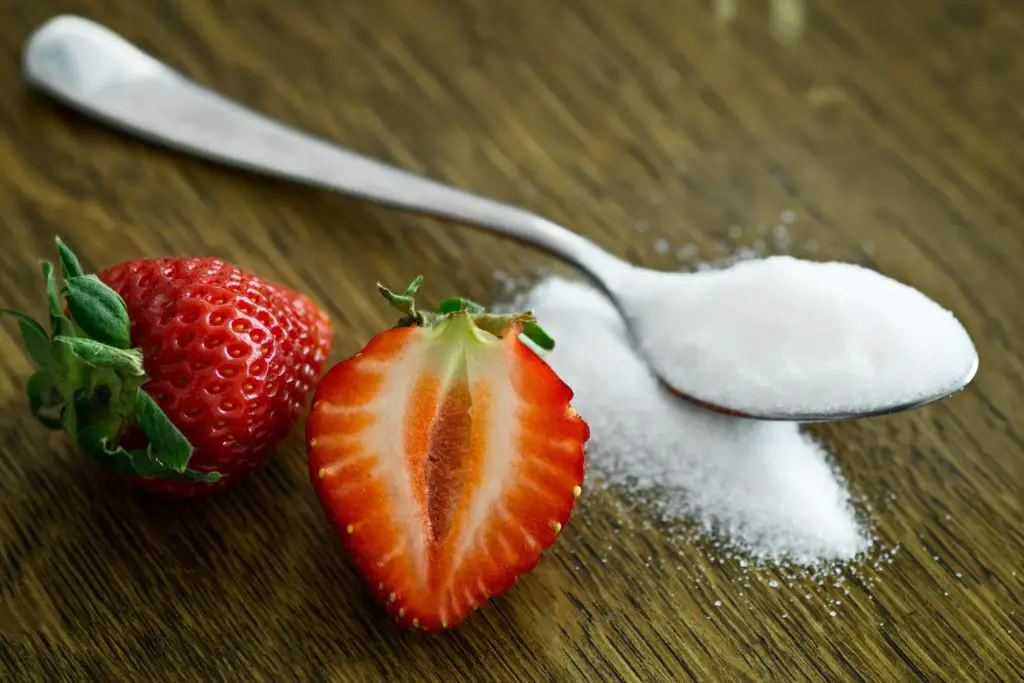
How Many Grams of Sugar Should A Teenager Have a Day?
Let’s look at the sugar recommendations:
- 2015-2020 Dietary Guidelines for Americans recommends consuming less than 10 percent of calories from added sugars.
- American Heart Association recommends no more than 6 teaspoons of added sugar per day for ages 2-18 (about 25 grams added sugar).
The 2020 Dietary Guidelines for Americans recommends to “Consume an eating pattern low in added sugars” and to “limit calories from added sugars” by “consuming less than 10 percent of calories per day from added sugars”.
When added sugars exceed over 10 percent of calories, it makes it difficult for individuals to also meet all other nutrient needs while staying within calorie limits. 10 percent of calories is about 12 teaspoons of sugar for a 2,000 calorie diet (48 grams).
Many teenagers need more than 2,000 calories per day, especially when they are growing and active in sports, but that doesn’t necessarily mean more sugar is okay and recommended.
The American Heart Association recommends no more than 6 teaspoons of added sugar per day for children and teens (about 25 grams) under 18 years old.
How Much Sugar Are Teens Typically Eating?
According to the National Cancer Institute, 14-18 year olds consume the most added sugar per day, about 34 or more teaspoons in a day! That’s a lot higher than the recommended 6-12 teaspoons (depending on the Dietary Guidelines or AHA), about triple the recommendation or more! That’s a problem. That’s too much sugar that is taking place of other important nutrients and foods in a teenager’s diet.
Decreasing added sugars is definitely do-able if you are aware of the common sources of added sugars for your teen and make some simple swaps. You don’t need to obsess about sugar amounts, but rather focus on limiting some of the products with high amounts of added sugars and add in a few healthier snacks.
Where Are Teens Getting Too Much Sugar?
Teenagers are becoming more independent and busy, and they are making a lot more of their own food choices, especially as they are away from home more often and have access to fast food, vending machines, drive-throughs, etc. Quick and easy highly processed foods and fast foods are popular among teenagers.
A Recent National Health and Nutrition Examination study, NHANES, found that sugar-sweetened beverages, snacks, and sweet bakery products contributed most to excess added sugars. These foods add a lot of calories and sugar, without contributing essential nutrients such as vitamins, minerals, and fiber to a teenager’s diet. Across all age groups in the study, added sugars exceeded the guidelines (no more than 10% of calories).
Here are the types of foods that contributed most to added sugars in teenager’s diets:
- Sugary beverages- soda, juice, flavored waters, Gatorade and energy drinks, and even coffee and teas.
- Snack foods- packaged snacks, cakes, cookies, crackers, chips
- Other treats- candy and chocolates, baked goods, ice cream
Why Is Sugar Bad For You? What Does Sugar Do To Your Body?
Now that you understand that added sugars are too high in most diets, what are the consequences and risks of too much sugar in our diets?
- Tooth decay and cavities. Especially stay away from the sticky, sugary foods and sugary beverages that stay on your teeth. Brush your teeth about 2 times per day.
- Raises your blood glucose (blood sugar) levels initially and can cause a “crash” later on. Unstable blood sugar levels can cause unhealthy cravings, mood swings, low energy levels, headaches, and fatigue.
- Increases your risk of diabetes, heart disease, and obesity, and possibly forms of cancer, and other health conditions which remain problematic into adulthood if not targeted early. It’s easier to develop healthy habits in the beginning then breaking bad habits later.
- Cravings for more sugar. It’s an addictive cycle.
- Decreases your immune system, and may cause inflammation.
- Affects your mood. Too much sugar can affect mental health, and cause irritability, and even affect your hormonal balance.
- Nutrient deficiencies. If you load up on sugary-foods and beverages, you probably aren’t eating enough nutritious foods that your body needs, which may lead to nutrient deficiencies over time such as vitamin A, vitamin C, vitamin B12, and calcium. Teenagers need the most nutrients and they consume the most sugar!
Avoiding added sugars is the goal, but it’s not as simple as it sounds because added sugars can be found in many founds where you wouldn’t expect it.
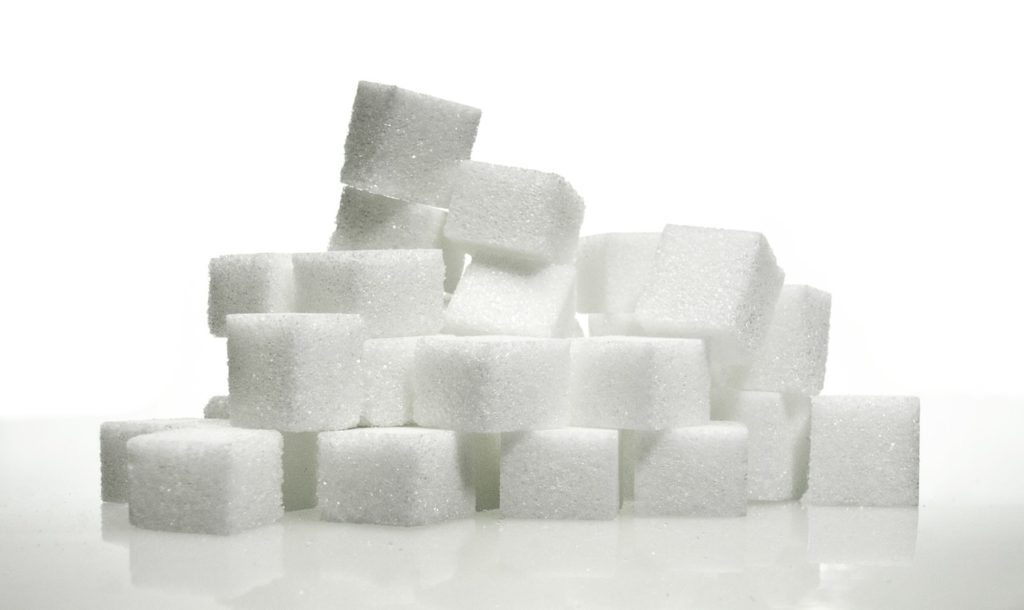
Is All Sugar Bad?
Not all sugar is bad for you, some sugar is natural and provides important energy for our bodies in the right amounts. Sugar has many names, including fruit sugar or fructose, carbohydrates, natural sugars, added sugars, etc. Here are some of the differences:
Natural Sugars
Natural sugars are an organic part of a food and are a good choice, they are good for your body and provide important energy as healthy carbohydrates. Natural sugars are found in dairy products (lactose) or in fruit (fructose) or vegetables. Natural sugars are good for you in appropriate amounts.
Example: Strawberry yogurt has naturally occurring sugars from the milk and strawberries. Both are natural and acceptable. Some strawberry yogurt might contain added sugars as a sweetener, this should be limited.
Added Sugars
The 2020 Dietary Guidelines for Americans states “added sugars include sugars, syrups and other caloric sweeteners.” Added sugars sweeten foods but offer no nutritional value, but it’s more than just table sugar, added sugars hide in many foods in many forms.
An added sugar is a sugar that is added during processing or preparation of a food to sweeten that food. Even if you’re really careful, your child may still be consuming more sugar than you think.
Luckily it is getting a little easier to be informed when making food decisions. Have you noticed the updated changes to the food labels? They now include added sugars. It makes it a lot easier to understand and realize what types of sweeteners are involved.
Check out the new nutrition facts label, which is easier to read and understand, especially relating to sugars. Sugars is now called “Total Sugars”. “Added Sugars” is now a helpful subcategory that is included underneath “Total sugars”. Now consumers can better understand how much of the total sugars comes from added sugars, the kind you want to limit.
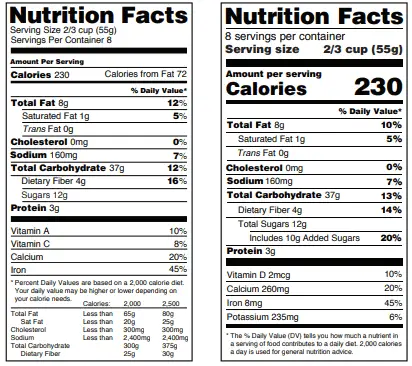
Luckily now the nutrition facts labels tells you the difference between total sugars and added sugars. You can also look at the ingredient list of a food to tell you the types of sugars in a product.
Ingredient label Names of Sugar
Sugar comes in many forms with many different names. There are more than 60 names for added sugar on ingredient labels, no wonder it can get confusing. Some of the common names of sugar you’ll see on an ingredient label include: sugar, brown sugar, cane sugar, high-fructose corn syrup, corn syrup, honey, glucose, maple syrup, molasses, brown rice syrup, malt, evaporated cane juice, raw sugar, sucrose, invert sugar, crystal solids, etc.
Here’s an example. How many types of added sugar are in this product?
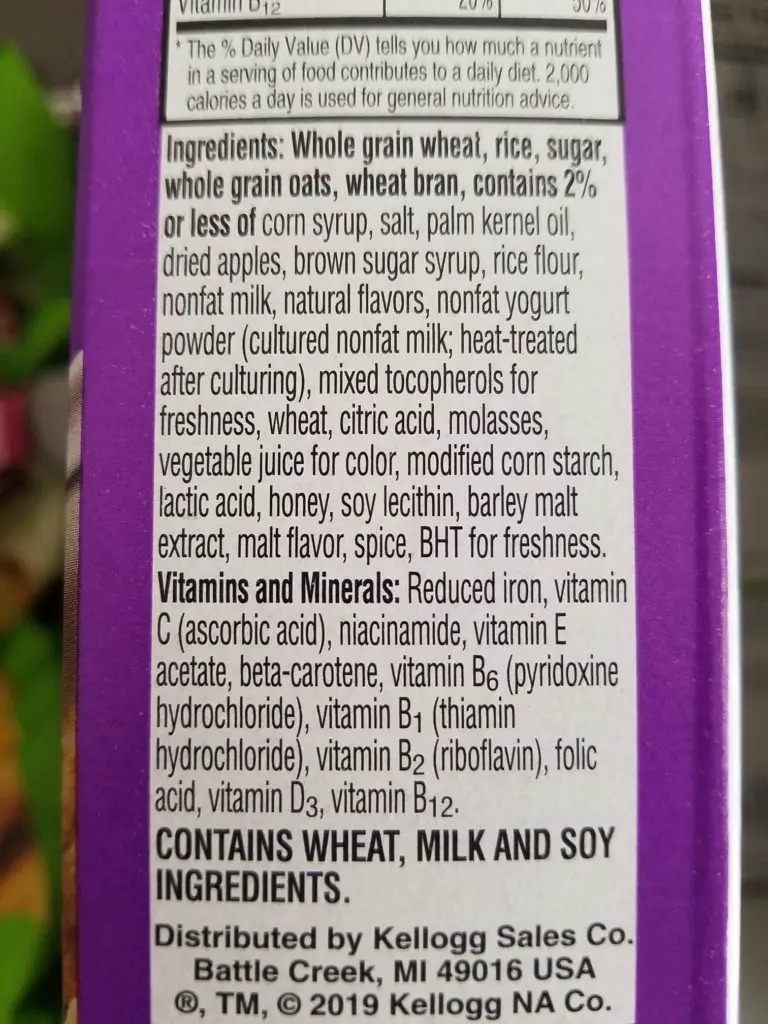
You can see quite a few types of sugar listed in the ingredients- sugar, corn syrup, brown sugar syrup, molasses, honey… did I miss any? It’s good to be aware of the added sugars you are eating.
Even though most of those sugars make up 2% or less of the total ingredients (listed below), there are still many types of sugar in this product! Can you guess what this product is? It’s a common breakfast cereal!
It can get confusing. Sometimes natural sugars are even considered added sugars when used in certain processed foods, the same as added sugar would be used. A natural sugar can be used as an added sugar (as a sweetener). If you see “fructose” (fruit sugar) listed on an ingredient label instead of the name of a fruit, you’ll know it’s an added ingredient.
Common Foods with Added Sugars
| Obvious Added Sugars | Hidden Added Sugars |
|---|---|
| -soda -sugary beverages -sugary breakfast cereal -candy -chocolate bars -treats -packaged snacks -flavored yogurt -baked goods (cookies, cakes) -ice cream and popsicles | -whole-grain cereals -granola -instant oatmeal -frozen meals -sauces and condiments (pasta sauce, salad dressings, bbq sauce, ketchup, jam) -granola bars -dried fruit -canned fruit -applesauce -fruit juice -baby food -Many low-carb or “diet” or “healthy” foods |
Tips to Decrease Added Sugars:
- Look at labels when shopping.
- Try using naturally sweet foods like fruit, sweet potatoes, avocado. Example: add a mashed banana to oatmeal instead of brown sugar.
- Choose low sugar beverages such as milk, water, unsweetened tea. You can also add fruit or herbs to flavor your water.
- Prepare food and bake at home so you know what is in your food and how much sugar you are using. Try making your own granola, yogurt (it’s easy if you have an Instant Pot), pasta sauce, homemade treats, etc.
How to Stick to the Recommended Amount of Sugars in a Day
14 year-olds should try not to eat more than about 25 grams of added sugar per day.
Here are some examples of what 6 teaspoons of sugar (25 grams) looks like:
- 8 oz of soda (a typical can or bottle is 12 oz)
- 44 M&M candies
- About 2 cups of Frosted Mini Wheats cereal
- 3 tablespoons of pancake syrup
- 6 Oreo cookies
- 3/4 cup vanilla ice cream
- 2 (6 oz) containers Yoplait yogurt
- 3 packets of instant oatmeal
Each of these examples equals about 25 grams of sugar. That’s the recommended limit for the day. That’s not a lot of sugar. It’s tough to stick to the recommendations, but it can totally be do-able if you are aware of the sources of added sugars in your teen’s diet. Start looking at food labels of your teenager’s commonly-consumed foods together to get an idea for their sugar intake.
Is it a Good Idea to Replace Added Sugars with Artificial Sweeteners?
It seems like a good idea to replace added sugars with artificial sweeteners. Artificial sweeteners are very sweet, provide little or no calories, and only a small amount is needed in food. Sounds tempting, but that doesn’t always make them a better choice.
The high-intensity sweeteners approved by the FDA include aspartame, saccharin, acesulfame-potassium, and sucralose. Based on scientific evidence, these have been determined to be safe for the general public, however, based on emerging research I believe we are better off not using artificial sweeteners very often. Artificial sweeteners may not be a good idea in the long run as they can disrupt our gut bacteria and blood sugar/insulin response.
Check out my post: Sugar-Free Kids? The Problem With Artificial Sweeteners for Children and Teens for more information on artificial sweeteners.
Tips for Parents to Promote Healthy Eating In Teens
If your teen is eating too much sugar, there are some simple goals you can work on to limit junk food and packaged foods with higher amounts of added sugars, and focus on real, whole foods that provide a lot more nutrition for your growing child. Don’t get overwhelmed, choose one tip at a time and commit to be a little bit better today than you were yesterday. Try some of these ideas:
- Keep healthy food easily accessible- cut up fruits and vegetables and store in clear containers (such as cut up watermelon, dip with cut up veggies, grab and go foods)
- Pack lunches. Have your teen help you and let them choose a favorite food along with healthier options
- Control what food is in the home. Not all junk food needs to be banned, but you don’t have to constantly buy soda, chips, ice cream, etc. Have a variety of healthy foods and some favorite foods and model healthy eating choices
- Talk to your teen about nutrition. Labels with “sugar-free” and “fat-free” may not be the right choice even though it seems healthier to a teen. Teens need some fat, but too much sugar is stored as extra fat on the body.
- Have teens around the kitchen as much as possible- have them help with meal planning and food prep, and even some grocery shopping. Take them to a new store or a farmer’s market to pick out some interesting and new fruits or vegetables to try. You’ll also build your relationship with your teen by spending time together working towards something, so it’s a win-win-win (dinner, healthy kids, time with kids).
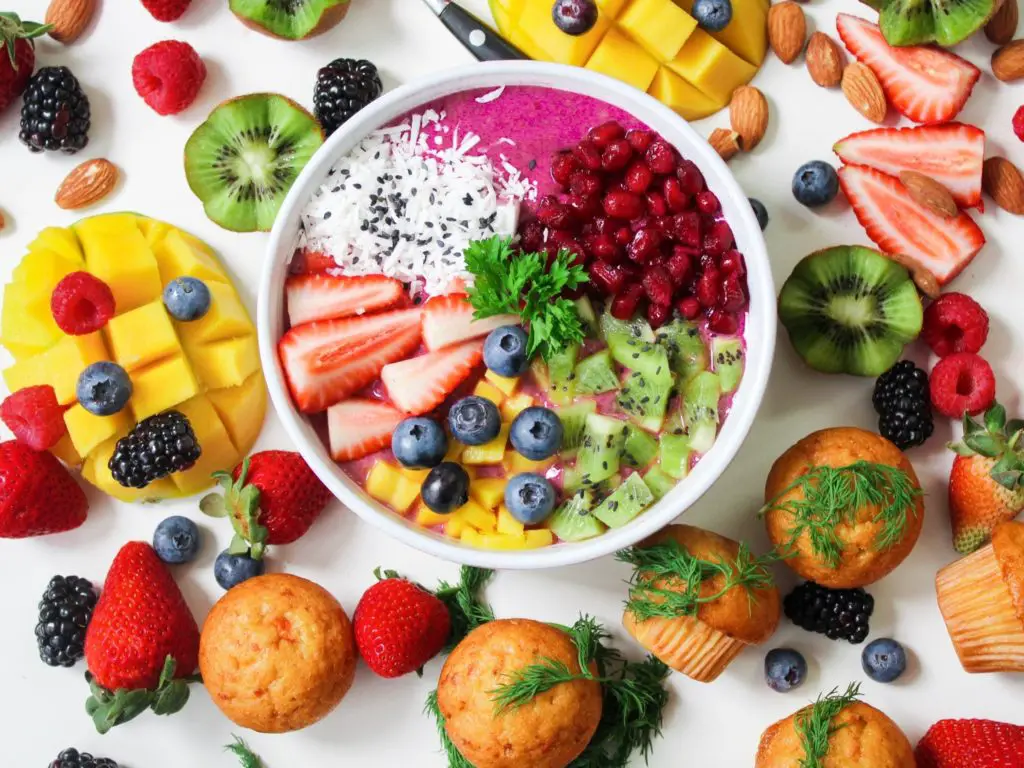
Best Healthy, Low-Sugar Snacks for Teens:
- 1/4 cup trail mix (mixed nuts, seeds, dried fruit, whole grain cereals)
- 1-2 cups Homemade fruit smoothie (frozen fruit, Greek yogurt, nut butter, chia or flax seeds, vegetables like spinach or zucchini, milk)
- 3 cups of homemade popcorn with a little seasoning like nutritional yeast, grated cheese, or dried spices.
- Roasted chickpeas (just as satisfying as a crunchy chip or baked fry)
- Baked vegetable chips
- Homemade dip for cut-up veggies such as hummus, Greek yogurt, cottage cheese. Try a new veggie like edamame or jicama.
- Homemade guacamole with whole-grain chips or crackers
- Cut-up fruit kabobs and low-fat yogurt dip (be careful, some brands of yogurt can have a lot of sugar.)
- Apple, celery, banana, or crackers with 1 tablespoon of nut butter
- Homemade smoothie popsicles
- Veggie pita pizza (top a pita with tomato sauce, veggies, and cheese and bake in oven for 5-10 minutes)
- Yogurt parfait with 6 ounces lowfat yogurt, 1/2 cup fruit, and 2-3 Tablespoons of lowfat granola
- Homemade oatmeal with milk, 1 tablespoon nut butter, and dried/fresh/frozen fruit
- 2 cups green salad with cup up apples, pecans, dried raisins or cranberries, and 2 Tablespoons low fat dressing
- Whole-wheat protein pancake with nut butter and fruit
- Quesadilla with a whole grain tortilla, 1/4 cup beans, 2 Tablespoons cheese, diced veggies, and your favorite salsa
- Veggie skewers with diced vegetables, grape tomatoes, cheese cubes, and tortellini or other pasta
- 3 oz tuna and whole wheat crackers
- 1 cup cottage cheese and fruit (try pineapple, pears, peaches, mandarin oranges, raspberries, etc.)
- 1 cup frozen grapes
- A small handful of raisins or favorite dried fruit with a square of dark chocolate
How Does Sugar Affect Teen Brains?
Too much sugar can negatively affect brain function, attention span, energy levels, mood, and more in teenagers.
The adolescent brain is sometimes more susceptible to these effects and a healthy diet is so important. A poor diet and too much sugar can also lead to poor mental health. Especially during school days it is important to limit sugar to be able to stay focused on classes, schoolwork, time with friends and family, etc.
Do Teen Athletes Need More Sugar?
Typically, athletes need to fuel their long, high-intensity exercises and games with simple sugars. If a teen athlete is exercising at high-intensity for long periods of time, their bodies might require extra sugars to keep their muscles fueled.
This doesn’t mean fueling up on soda, Poptarts, ice cream, and candy bars. Teen athletes need to be careful and specific about the types of sugars they put into their bodies.
A better choice during a long, intense workout would be a carbohydrate drink such as Gatorade, or better yet- choose fruit. Don’t go overboard, an athlete needs about 10-20 grams of extra sugar per hour of vigorous activity. That’s about 1 apple (19 grams) or orange (9 grams), 1 cup of grapes (15 grams), 1 medium banana (14 grams), 1 slice of watermelon (16 grams), etc.

What Happens to Your Body if You Stop Eating Sugar?
Too much sugar can do a lot of harm to your body. Luckily the best solution is fairly simple- stop eating so much sugar and cut some, or all, of it out of your diet.
If you are eating way too much sugar each day (remember most 14 year-old teenagers are eating triple the recommendation) and decide to stop eating sugar, you may go through withdrawal symptoms at first and it can be a tough transition.
That can be hard on your body when you are used to constant sugar intake. You can get headaches, fatigue easily, become irritable, feel anxious and depressed, etc. It’s still a good idea to limit your sugar consumption.
These side effects typically only last a few days and then you’ll be feeling much better without as much sugar. Your body will thank you.
Decreasing sugar intake will lower inflammation, boost your energy levels, improve your focus (which is especially important in school), improve your mood, improve your sleep, and possibly decrease acne, help you lose weight, and decrease cravings.
Summary
As teens are away from home more, parents have less control over what their teen eats. Start young to teach healthy principles and your teen will navigate a birthday party, team buffet dinner, or fast-food run successfully by themselves. Important habits taught now will benefit a teenager’s life for their future.
Related Questions
Does Sugar Really Cause Hyperactivity? Although many parents swear that sugar makes their children hyper and bouncing off the walls, a large body of research shows there is no link between the two. It’s common for parents to automatically assume their kids are more crazy after having consumed sugar.
Actually, your child is just wired because of the excitement going on around them, the excitement from being able to have birthday cake, soda, or cookies gets them more excited and hyper than actually eating the sugar does. Don’t blame sugar for your child’s bad behavior, but don’t allow heaps of sugar all day either. There’s a good balance.
How Many Carbs Do Teenagers Need Each Day? Typical recommendations for carbohydrates for teenagers is 45-65% of total calories should come from carbohydrates each day. On a 2,000 calorie diet that’s 225-325 grams. On a 3,000 calorie diet that’s 338-488 grams per day.
Sugar is another name for carbohydrates, which is important fuel for your body. Added sugars are a type of simple carbohydrates. Choose carbohydrates from healthy sources such as fruits and vegetables, low-fat dairy products, and whole grains. Limit intakes of added sugars.
Does Sugar Affect ADHD? Despite popular sayings, sugar intake does not contribute to hyperactivity and ADHD, however high intakes of regular sugar intake may affect mood and energy levels.
Does the Brain Need Sugar? Yes, the brain uses glucose as energy, which is a form of sugar. The brain needs a lot of energy, it is the main consumer of glucose in your body. Your body converts types of sugars that you eat into glucose, however, too much of a good thing can be a bad thing.
See Also:
- What is the Best Diet Plan for a 15 Year-Old to Lose Weight?
- How Many Eggs Can a Teenager Eat Per Day?
- Is it OK for Teens to be Dairy-Free?
- How Many Calories Should a 14 Year-Old Eat?
- Is Whey Protein Safe for Teenage Athletes?
- Free Meal Plan for High School Football Players
References:
Dietary Guidelines 2015-2020. https://health.gov/our-work/food-nutrition/2015-2020-dietary-guidelines/guidelines/chapter-1/a-closer-look-inside-healthy-eating-patterns/#callout-dietaryfats
Academy of Nutrition and Dietetics. Smart Snacking for Adults and Teens. 2017. https://www.eatright.org/-/media/files/eatrightdocuments/nnm/smartsnackingforadultsandteens.pdf?la=en&hash=CA7BDF27EB5947E8C56528534C7BE9BC5C4B54E8
Academy of Nutrition and Dietetics. Sugar: Does It Really Cause Hyperactivity? Written By Karen Ansel, MS, RDN, CDN. Published August 20, 2018. https://www.eatright.org/food/nutrition/dietary-guidelines-and-myplate/sugar-does-it-really-cause-hyperactivity
Written by Katherine Harmer, RDN
Fueling Teens is a participant in the Amazon Services LLC Associates Program, an affiliate advertising program designed to provide a means for sites to earn advertising fees by advertising and linking to Amazon.com. We also participate in other affiliate programs which compensate us for referring traffic.

